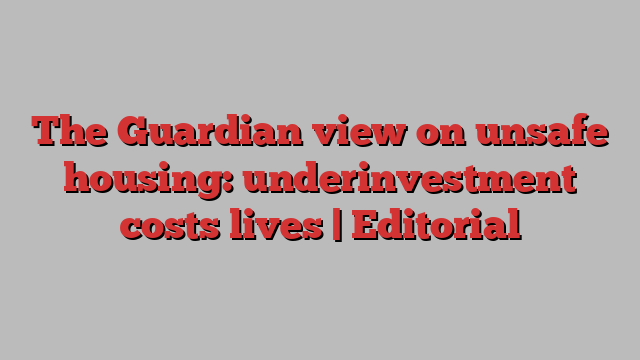
The details revealed at the inquest of Awaab Ishak, who died aged two in December 2020 due to respiratory problems caused by mould growing in his family’s flat, were shocking. His father had repeatedly complained to their landlord, Rochdale Boroughwide Housing. A health visitor had sent two letters warning of the risks. But nothing was done.
After last week’s verdict blamed the toddler’s death on mould, with the coroner saying that the tragedy should be a “defining moment”, the housing mutual initially held on to its chief executive, Gareth Swarbrick, but then fired him at the weekend. While his public disgrace may afford some satisfaction to Awaab’s grieving relatives, and to other tenants anxious to see housing bosses held accountable, the serious problems in England’s social housing stock go far beyond one man and one organisation.
In 2020, 2.2m homes in England had at least one category 1 hazard – those with the highest risks – and 941,000 had serious damp. In the year to April 2022, complaints to the social housing ombudsman about damp, mould and leaks almost doubled. This situation is expected to deteriorate further as a result of rising energy bills, which will lead to some tenants keeping their heating off. The situation in the private rented sector – where tenants have no recourse to the ombudsman – is significantly worse.
New laws promised after the Grenfell Tower disaster have been too long in coming, as Michael Gove, the levelling up secretary, has admitted. The social housing regulation bill is yet to go through its committee stage in the Commons. But once passed, it should make it easier to identify social landlords who are failing their tenants. Inspections will also become more robust. But the bill does not go far enough, and should be amended to ensure that housing managers are qualified. Currently, there is no requirement for any professional training, which is wrong given the power that landlords wield over people’s lives, including their health.
Tougher inspections and strengthened tenants’ rights will raise the pressure on landlords, and could lead to improvements. But they cannot fix the underlying problem of underinvestment. Much of England’s housing stock is hopelessly out of date, and standards on new-builds have not been high enough. The assault on regulation initiated by David Cameron, as part of the coalition’s austerity programme, meant that constraints on developers were weakened at the same time as local authority housing budgets were slashed. Public investment in housing has never returned to its pre-2010 level.
Around 1.2 million people are on waiting lists, while some housing associations, in their rush to expand, seem to have abandoned their social purpose. Budgets for building new homes and fixing old ones are far too low, and unlikely to rise in the foreseeable future. If anything, they are more likely to shrink, since the 7% cap on rent rises is lower than inflation. Mr Gove wrote to housing providers at the weekend to say that he was putting them “on notice”. Given the government’s role in running down the nation’s housing stock, the same message could be sent to Mr Gove and his cabinet colleagues.